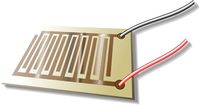Moisture Sensor: Difference between revisions
From DT Online
(Moisture Sensor) |
mNo edit summary |
||
| (5 intermediate revisions by the same user not shown) | |||
| Line 2: | Line 2: | ||
Moisture [http://en.wikipedia.org/wiki/Sensor '''sensors'''] consist of a flat plate with two conductors etched upon them. They can come in different shapes. | Moisture [http://en.wikipedia.org/wiki/Sensor '''sensors'''] consist of a flat plate with two conductors etched upon them. They can come in different shapes. | ||
The type illustrated gives maximum intimacy between conductors for a given surface area. Another type takes the form of a long strip with the conductors running parallel to themselves. When moisture bridges the gap, the resistance is lowered between the conductors. This drop in resistance can trigger a '''[[Transistor|transistor]]''' circuit, which in turn could operate a '''[[ | The type illustrated gives maximum intimacy between conductors for a given surface area. Another type takes the form of a long strip with the conductors running parallel to themselves. When moisture bridges the gap, the resistance is lowered between the conductors. This drop in resistance can trigger a '''[[Transistor|transistor]]''' circuit, which in turn could operate a '''[[Relays|relay]]'''. | ||
'''Uses:''' Plant watering in dry weather, sensing when it rains, flood warning, sensing damp conditions in electrical equipment etc. | '''Uses:''' Plant watering in dry weather, sensing when it rains, flood warning, sensing damp conditions in electrical equipment etc. | ||
[[Category:Secondary]] | |||
[[Category:Electronics Components]] | |||
Latest revision as of 08:19, 3 June 2015
Moisture sensors consist of a flat plate with two conductors etched upon them. They can come in different shapes.
The type illustrated gives maximum intimacy between conductors for a given surface area. Another type takes the form of a long strip with the conductors running parallel to themselves. When moisture bridges the gap, the resistance is lowered between the conductors. This drop in resistance can trigger a transistor circuit, which in turn could operate a relay.
Uses: Plant watering in dry weather, sensing when it rains, flood warning, sensing damp conditions in electrical equipment etc.
